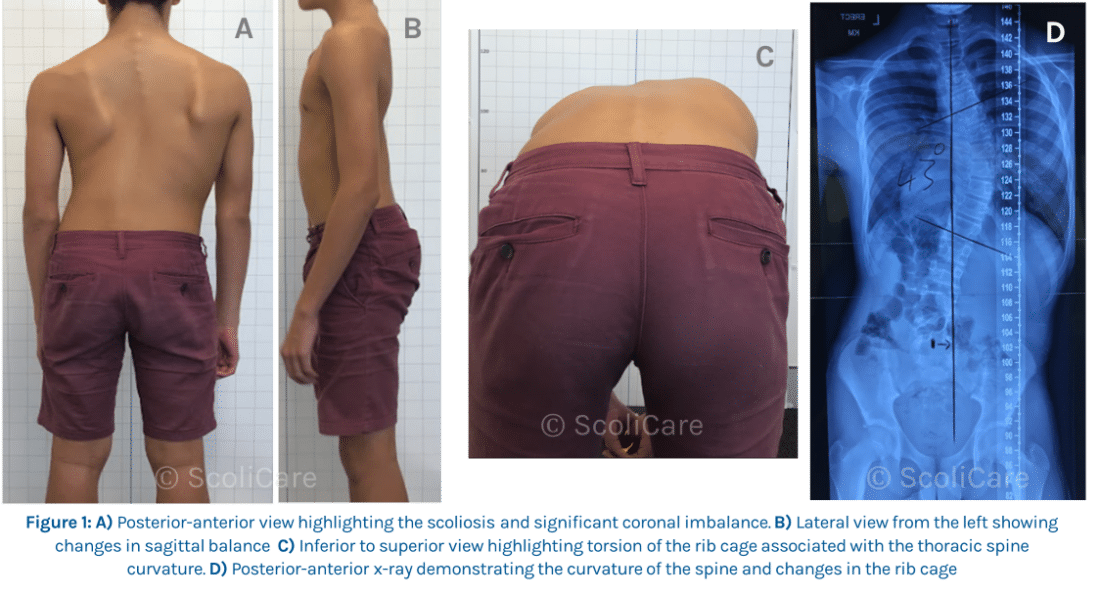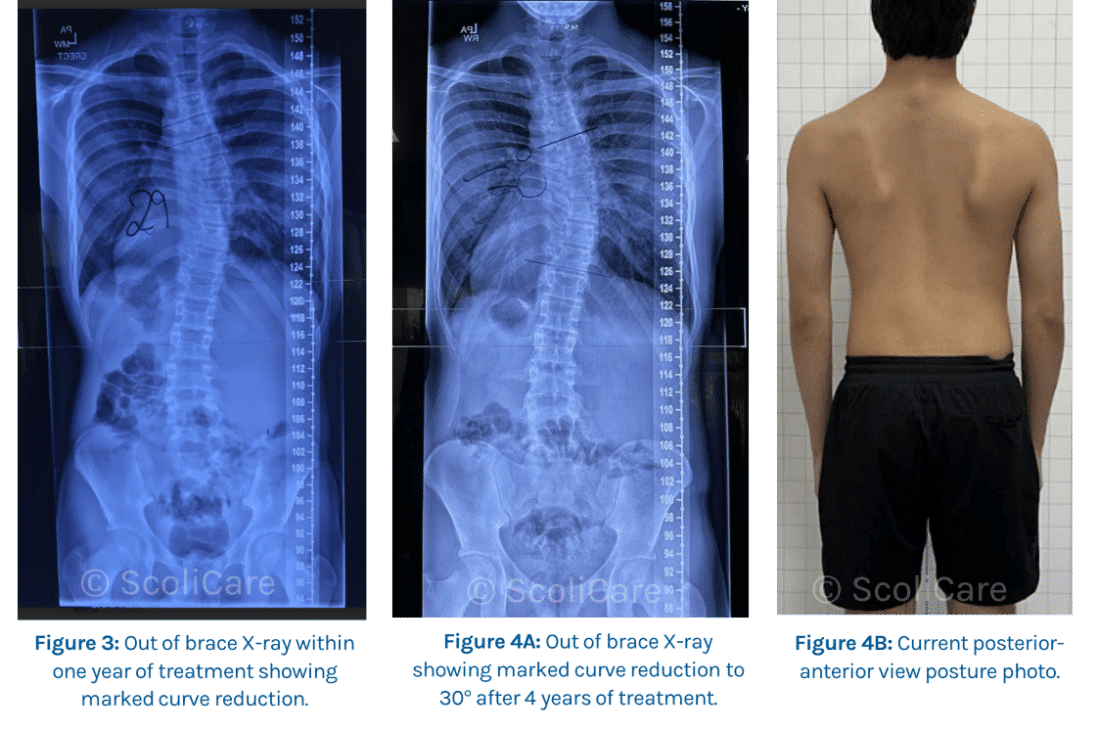Male aged 12 years with a 43° right thoracic curve.
Reduction of a severe scoliosis using a 3D designed custom scoliosis brace in a young active male.
Summary:
This case details the successful management of a young active male that enjoys swimming and soccer with a severe adolescent idiopathic scoliosis (AIS) using a 3D designed custom scoliosis orthosis and ScoliBalance, which is a physiotherapeutic scoliosis specific exercise (PSSE) program. The patient initially presented to the clinic at 12 years of age with a 43° right thoracic scoliosis. The curve had progressed from 37° in just two months. There was significant right translation in the coronal plane as there was no lumbar compensatory curve. There was a suspected curve for 18 months, however the practitioner at the time suggested the patient would grow out of it.
The patient was recommended treatment of a a 3D designed custom rigid thoracolumbosacral orthosis (TLSO) combined with ScoliBalance scoliosis specific exercises.
Within the first year of treatment, the curve had reduced from 43° down to 29° out of brace and has subsequently remained stable at 30°. The patient’s posture and coronal imbalance has also significantly improved to date.
Case Background
The patient presented to ScoliCare at the age of 12 with a 43° right thoracic curve, which had progressed rapidly from 37° just two months earlier.
With a strong family history of scoliosis, the main reason for the consultation was concern over further curve progression. The initial diagnosis was made 18 months prior to the patient presenting at ScoliCare, however the patient at the time was told they would likely grow out of the curve.
Examination Findings
The examination revealed some significant postural changes, as the patient was translated to the right in the coronal plane (Figure 1A). Also notable from the side-view was the significant hypokyphosis (Figure 1B) and torsion of the ribcage (Figure 1C).
Posture also shows a right head shift, right shoulder elevation, right scapular protrusion, and an asymmetry in waste angle (Figure 1 C). X-rays taken at the time showed a large right thoracic curve of 43° with no lumbar compensatory curve (Figure 1D). The patient at the time was only a Risser stage 2, meaning that there was still a significant amount of skeletal growth remaining.

Intervention
The patient was recommended bracing for 23 hours a day using a a 3D designed custom scoliosis brace. This was in conjunction with a ScoliBalance program of physiotherapeutic scoliosis specific exercises (PSSE), 5 to 7 days a week.
The brace wear was increased in 2 hour increments up to 23 hours per day, until the patient had stopped growing skeletally. The scoliosis specific exercises were a tailored to the patient’s curve type, symptoms, and treatment goals in conjunction with the SOSORT guidelines. New exercises were added to the programme as the patient progressed and regular follow-ups were conducted to manage the patient’s response to treatment and compliance.
Outcomes
The patient was extremely compliant with both brace wear and prescribed ScoliBalance exercises both in the clinic and at home. Their spine responded well to treatment, with curve progression stabilising early on.
Within the first year of treatment, the curve had reduced from 43° down to 29° out of brace (Figure 3).
The patient is still currently undergoing treatment however, the most recent out of brace X-rays show a significant reduction in curve size from 43°. The curve has stabilised at 30° out of brace and there are no developments of compensatory curves (Figure 4A). The patient’s coronal imbalance has also improved significantly (Figure 4B).

Discussion
Bracing and Physiotherapeutic scoliosis specific exercises (PSSE) are recommended for moderate curves between 20° to 45°. This patient’s initial curve was 43° at the time of initial presentation, putting him very close to the surgical threshold. However, as he presented as a Risser stage 2 he still had a fair amount of skeletal growth left, providing the opportunity to growth modulate the curve with bracing and exercise.
Due the patient’s consistent commitment to treatment over the past four years thus far, the curve was able to be reduced from 43° at the time to a stabilised 30° out of brace.
Conclusion
This case demonstrates the reduction of a borderline severe scoliosis in an AIS patient who through committed treatment using a a 3D designed custom scoliosis orthosis and scoliosis specific exercises, was able to halt curve progression and even show improvement in both curve size and overall posture.
© ScoliCare
NB: Results vary from case to case. Our commitment is to recommend the most appropriate treatment based on the patients type and severity of scoliosis.
The post Case – Adolescent Bracing (12 year old male) appeared first on ScoliCare.
